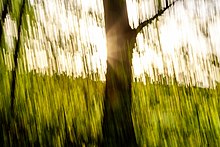Shaky camera

Shaky camera,
Too much shaky camera motion can make some viewers feel distracted, dizzy or sick.[6][7]
History
Traditionally, still and motion
Hand-held camera movements became more prominent in some
In 1981, the "shaky cam" style was named, and given new energy.
In 1984, the
The 1993's police drama NYPD Blue is recognized by many[who?] as the first television show to use shaky and swooping shots for most of its camera work. In 1994, the TV series ER employed shaky camera techniques, as did the 1996 disaster film Twister.[12] Danish director Lars von Trier used shaky camera, called 'free camera', in his movies. The Dogme 95 movement he co-created in 1995 was partly based on the technique.[4] Trier's 2000 film Dancer in the Dark was criticized for having too much shaky camera motion.[4]
Reactions

Several films have been criticized for excessive shaky camera technique. The
The films Friday Night Lights (2004),[14] Cloverfield (2008)[7] and American Honey (2016)[citation needed] have been described as making viewers nauseated or sick.
Director Christopher McQuarrie has criticized the technique as a gimmick used to try and hide the lack of real energy in a scene.[15]
See also
- Direct cinema
- Dutch angle
- Found footage (pseudo-documentary)
- Jump cut
- Pan and scan
- Tilt (camera)
References
- ^ a b c Mekas, Jonas. "A Note on the Shaky Camera." Film Culture, issues 24-27, 1962.
- ^ ISBN 1-55783-607-8
- ^ "Queasy-cam face-off". www.theaustralian.com.au. 2011-09-09. Retrieved 2019-08-20.
- ^ a b c d e f g h Bordwell, David; Kristin Thompson. "Unsteadicam chronicles." Observations on film art, August 17, 2007. Retrieved on October 2, 2009.
- ^ ISBN 0-8131-9041-X
- ^ a b c Ebert, Roger. "The Shaky-Queasy-Utimatum." RogerEbert.com, August 22, 2007. Retrieved on October 2, 2009.
- ^ a b Dellorto, Danielle. "Scary movie making viewers sick". www.cnn.com. Retrieved 2018-01-03.
- ^ "The End of the Shaky Camera". Videomaker.com. Retrieved 2018-01-03.
- ISBN 978-1-84150-335-6.
- ^ a b Von Busack, Richard. "Fresh 'Blood': The re-release of 'Blood Simple' shows the Coen brothers learning the ropes." Metroactive.com Movies. July 13–19, 2000. Retrieved on October 2, 2009.
- ^ ISBN 0-684-83374-3
- ^ Burke-Weiner, Larry. How the Masters Move: Creative Camera Play, Videomaker.com. July 1997. Retrieved on October 2, 2009.
- ^ Nix. "Saving Private Ryan (1998) Movie Review." Archived 2008-09-19 at the Wayback Machine BeyondHollywood.com, May 25, 2002. Retrieved on October 2, 2009.
- ^ "Film Monthly.com – Friday Night Lights (2004)". www.filmmonthly.com. Retrieved 2018-01-03.
- ^ "Interview: Christopher McQuarrie". Film Comment. 2015-07-30. Retrieved 2019-08-20.
